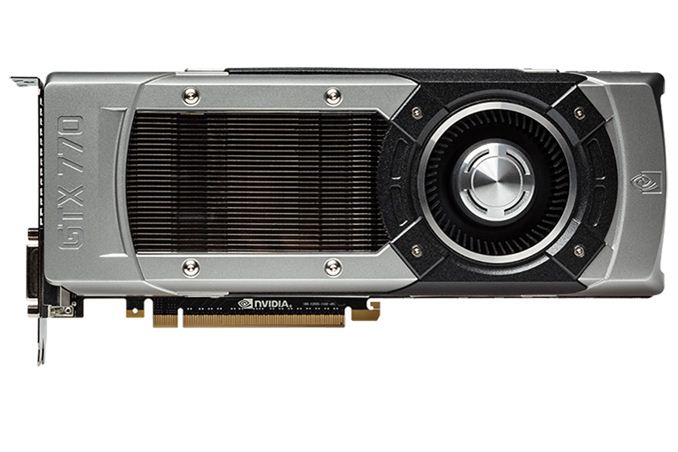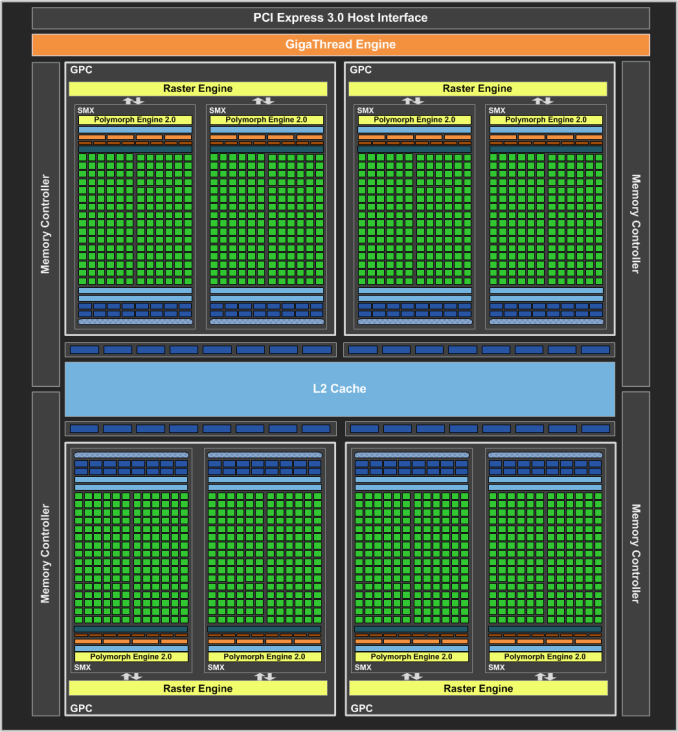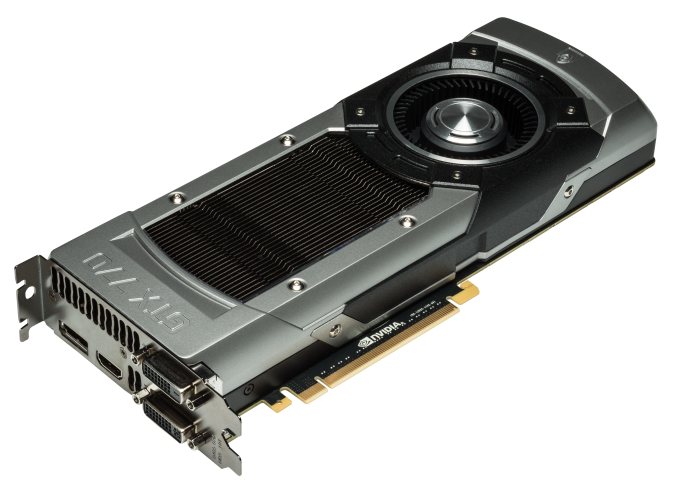NVIDIA GeForce GTX 770 Review: The $400 Fight
by Ryan Smith on May 30, 2013 9:00 AM EST
As spring gets ready to roll over to summer, last week we saw the first phase of NVIDIA’s annual desktop product line refresh, with the launch of the GeForce GTX 780. Based on a cut-down GK110 GPU, the GTX 780 was by most metrics a Titan Mini, offering a significant performance boost for a mid-generation part, albeit a part that forwent the usual $500 price tier in the process. With the launch of GTX 780 the stage has been set for the rest of the GeForce 700 series refresh, and NVIDIA is wasting no time on getting to the next part in their lineup. So what’s up next? GeForce GTX 770, of course.
In our closing thoughts on the GTX 780, we ended on the subject of what NVIDIA would do for a GTX 770. Without a new mid/high-end GPU on the horizon, NVIDIA has instead gone to incremental adjustments for their 2013 refreshes, GTX 780 being a prime example through its use of a cut-down GK110, something that has always been the most logical choice for the company. But any potential GTX 770 is far more nebulous, as both a 3rd tier GK110 part and a top-tier GK104 part could conceivably fill the role just as well. With the launch of the GTX 770 now upon us we finally have the answer to that question, and the answer is that NVIDIA has taken the GK104 option.
What is GTX 770 then? GTX 770 is essentially GTX 680 on steroids. Higher core clockspeeds and memory clockspeeds give it performance exceeding GTX 680, while higher voltages and a higher TDP allow it to clock higher and for it to matter. As a result GTX 770 is still very much a product cut from the same cloth as GTX 680, but as a fastest GK104 card yet it is a potent successor to the outgoing GTX 670.
| GTX 770 | GTX 680 | GTX 670 | GTX 570 | |
| Stream Processors | 1536 | 1536 | 1344 | 480 |
| Texture Units | 128 | 128 | 112 | 60 |
| ROPs | 32 | 32 | 32 | 40 |
| Core Clock | 1046MHz | 1006MHz | 915MHz | 732MHz |
| Shader Clock | N/A | N/A | N/A | 1464MHz |
| Boost Clock | 1085MHz | 1058MHz | 980MHz | N/A |
| Memory Clock | 7GHz GDDR5 | 6GHz GDDR5 | 6GHz GDDR5 | 3.8GHz GDDR5 |
| Memory Bus Width | 256-bit | 256-bit | 256-bit | 320-bit |
| VRAM | 2GB | 2GB | 2GB | 1.25GB |
| FP64 | 1/24 FP32 | 1/24 FP32 | 1/24 FP32 | 1/8 FP32 |
| TDP | 230W | 195W | 170W | 219W |
| Transistor Count | 3.5B | 3.5B | 3.5B | 3B |
| Manufacturing Process | TSMC 28nm | TSMC 28nm | TSMC 28nm | TSMC 40nm |
| Launch Price | $399 | $499 | $399 | $349 |
With GTX 780 based on GK110, GTX 770 gets to be the flagship GK104 based video card for this generation. At the same time to further differentiate it from the outgoing GTX 680, NVIDIA has essentially given GK104 their own version of the GHz Edition treatment. With higher clockspeeds, a new turbo boost mechanism (GPU Boost 2.0), and a higher power limit, GTX 770 is GK104 pushed to its limit.
The end result is that we’re looking at a fully enabled GK104 part – all 32 ROPs and 8 SMXes are present – clocked at some very high clockspeeds. GTX 770’s base clock is set at 1046MHz and its boost clock is at 1085MHz, a 40MHz (4%) and 27MHz (3%) increase respectively. This alone doesn’t amount to much, but GTX 770 is also the first desktop GK104 part to implement GPU Boost 2.0, which further min-maxes NVIDIA’s clockspeeds. As a result being that GTX 770 reaches its highest clocks more often, making the effective clockspeed increase greater than 4%.
But the more breathtaking change will be found in GTX 770’s memory configuration. With GTX 680 already shipping at 6GHz there’s only one way for NVIDIA to go – up – so that’s where they’ve gone. GTX 770 ships with 7GHz GDDR5, making this the very first product to do so. This gives GTX 770 nearly 17% more memory bandwidth than GTX 680, an important increase for the card as the 256bit memory bus means that NVIDIA has no memory bandwidth to spare for GTX 770’s higher GPU throughput.
We’ve talked in length about GDDR5 memory controllers before, noting that 7GHz has always been the planned limit for GDDR5. Good GDDR5 memory can hit it easily enough, but GPU memory controllers and memory buses are another matter. After faltering with the Fermi generation NVIDIA was able to hit 6GHz on their first shot with GK104, and now with their second shot and a new PCB NVIDIA is ready to certify GK104 as 7GHz capable. Given all the teething GDDR5 has gone through on both sides of the aisle, this is a small but impressive achievement for NVIDIA.
Moving on, between the higher GPU clockspeeds, higher memory clockspeeds, and the introduction of GPU Boost 2.0, NVIDIA is also giving GTX 770 a hearty increase in TDP, for both the benefits and drawbacks that brings. GTX 770’s TDP is 230W versus GTX 680’s 195W, and due to GPU Boost 2.0 the old 170W “power target” concept is going away entirely, so in some cases the difference in effective power consumption is going to be closer to 60W. Like GTX 780, this higher TDP is a natural consequence of pushing out a faster part based on the same manufacturing process and architecture, and we expect this to be the same story across the board for all of the GeForce 700 series parts. At the same time however we’d point out that the 230W TDP higher than usual for a sub-300mm2 GPU, reflecting the fact that NVIDIA really is pushing GK104 to its limit here.
Along with differentiating the GTX 770 from the GTX 680, these small improvements also serve to further separate the GTX 770 from the GTX 670, which because it’s based on the same GPU, makes this to some extent necessary to provide the necessary performance gains to justify the mid-generation refresh. As GTX 670 was a lower clocked part with only 7 of 8 SMXes enabled, the performance difference between it and the GTX 770 ends up being due to a combination of those two factors. With a clockspeed difference of 131MHz (14%), the theoretical performance difference between the two cards stands at about 30% for shading/texturing, 14% for ROP throughput, and of course 17% for memory bandwidth. This won’t be nearly enough to justify replacing a GTX 670 with a GTX 770, but it makes it a respectable increase as a mid-generation part, and very enticing for those GTX 470 and GTX 570 owners on 2-3 year upgrade cycles.
Moving on to the launch and pricing, unlike the GTX 780 last week, NVIDIA is being far more aggressive on pricing with the GTX 770, catching even us by surprise. From a performance standpoint the GTX 770 already makes the GTX 680 redundant, and if the performance doesn’t do it then the launch price of $399 will. $399 also happens to be the same price the GTX 670 launched at, so this is a fairly straightforward spec-bump in that respect.
At the same time NVIDIA is going to be phasing out the GTX 680 and GTX 670, so while these parts may see some sales to clear our inventory there won’t be any kind of official price cut. As such other than their lower TDPs these parts are essentially redundant at the moment.
For this reason NVIDIA’s real competition will be from AMD, with the $399 price tag putting the GTX 770 somewhere between AMD’s Radeon HD 7970 and Radeon HD 7970 GHz Edition. The price of the GTX 770 is going to be closer to the former while the performance is going to be closer to the latter, which will put AMD in a tight spot. AMD’s saving throw here will be their game bundles; NVIDIA isn’t bundling anything with the GTX 770, while the 7970 cards will come with AMD’s huge 4 game Level Up with Never Settle Reloaded bundle.
Finally, today’s launch is going to be a hard launch just like GTX 780 last week. Furthermore NVIDIA’s partners will be shipping semi-custom cards right at launch, and in fact we aren’t expecting to see any reference cards for sale in North America. This means there will be a great variety among cards, but not necessarily much in the way of consistency.
| May 2013 GPU Pricing Comparison | |||||
| AMD | Price | NVIDIA | |||
| AMD Radeon HD 7990 | $1000 | GeForce GTX Titan/GTX 690 | |||
| $650 | GeForce GTX 780 | ||||
| Radeon HD 7970 GHz Edition | $440 | GeForce GTX 680 | |||
| $400 | GeForce GTX 770 | ||||
| Radeon HD 7970 | $380 | ||||
| $350 | GeForce GTX 670 | ||||
| Radeon HD 7950 | $300 | ||||





_box_card_thumb.png)











117 Comments
View All Comments
mapesdhs - Friday, May 31, 2013 - link
I've just bought two 3GB 580s for 450 UKP total, will be benching them next week
single & SLI. If you're interested in the results, let me know by PM/email (or Google
"SGI Ian" to find my contact page) and I'll send you the info links once the tests are
done. I'll be testing with 3DMark06, Vantage, 3DMark11, Firestrike, Call of Juarez,
Stalker COP, X3TC, PT Boats, Far Cry 3, and all 4 Unigines (Sanctuary, Tropics,
Heaven and Valley). If I'm reading reviews correctly, two 580s SLI should beat a 780.
If your existing 580 is a 1.5GB card, note you can get a 2nd one off eBay these days
for typically less than 150 UKP. I've won two this month, a Zotac card for 123 UKP
(using it to type this post) and an EVGA card for 142 UKP.
And yes, I agree, the new gen card pricing is kinda nuts. Anyone would think
we haven't had a recession. I doubt peoples' budgets have suddenly become
30% higher (only reason I could buy some is I sold some of my other stuff to
cover the cost). The two 3GB 580s I bought were in total 100 UKP less than the
cheapest 780 from the same seller (I probably could have eventually obtained
two 3GB 580s off eBay, but decided the chance to get them from a proper
retailer right now with warranty, etc. was too good to pass up).
Ian.
colonelclaw - Saturday, June 1, 2013 - link
Thanks for the reply, Ian. For some reason I'd totally forgotten about SLI. I'd be very interested to see the results of a 580 SLI vs. 780, and I suspect a few other readers here would too. One thing, how closely matched do the two cards have to be? Exactly the same model? Just the same clock speeds? Or is it more forgiving? I can't imagine it would be very easy to track down a 2nd identical 580, which is the reason I ask. If any Anand readers with knowledge of SLIing can share their experiences that would be great.shompa - Friday, May 31, 2013 - link
Memory... How many games are 64bit? = How many games needs more then 4gig memory? Today zero. It was even more fun when most PCs had BIOS. It cant even address that much graphic memory.Maybe 64bit gaming will be mainstream in a year? I don't know. I sure seems to take its time. I have used 64 bit in my work since 1995 (real computers) and 64bit on my mac since 2002. (OSX 10.27 Smeagol). Gaming/Windows takes its time since Windows don't have smart software packaging. (real computers have the same binary for 32/64bit, different languages and even different architectures. I loved when Apple had "fat binaries" and everything could run on both PPC and X86. Gives the customer a choice of architecture.)
SymphonyX7 - Friday, May 31, 2013 - link
Looks more like a GTX 680 Plus. The gains over the year-old GTX 680 and HD 7970 Ghz edition are measly and power efficiency was thrown in as an afterthought.I'll wait for the HD 8950 and HD 8970 or whatever they'll call it before I make a decision. I suppose it's worth the wait considering what implications the new PS4 and Xbox One will have on game development and their impact on PC ports performance-wise.
kwrzesien - Monday, June 24, 2013 - link
4GB models have appeared at Newegg: http://www.newegg.com/Product/Product.aspx?Item=N8...Colin.B - Tuesday, July 9, 2013 - link
I just ordered the Gigabyte GTX 770, sold one of my 660 SCs for 160 dollars and am returning the one I just bought. Will I see a big performance drop from 660 SLI to the 770 at 2560x1440? I hope I made the right choice :/